Introduction
The Arc’teryx Norvan VT 2 shoe (11.3 oz / 320 g per shoe, $170) is specifically built for trail running and includes several features making it ideal for lightweight backpacking across different landscapes.
With a sleeker and more refined design than most other trail running shoes, the Norvan VT 2 is an aesthetically appealing shoe that is thoughtfully built around the human foot. It provides above-average protection and performance when hiking or running on rocky, uneven ground and doesn’t sacrifice comfort or breathability in doing so. Unfortunately, the shoe suffers from what can most charitably be described as abysmal durability.
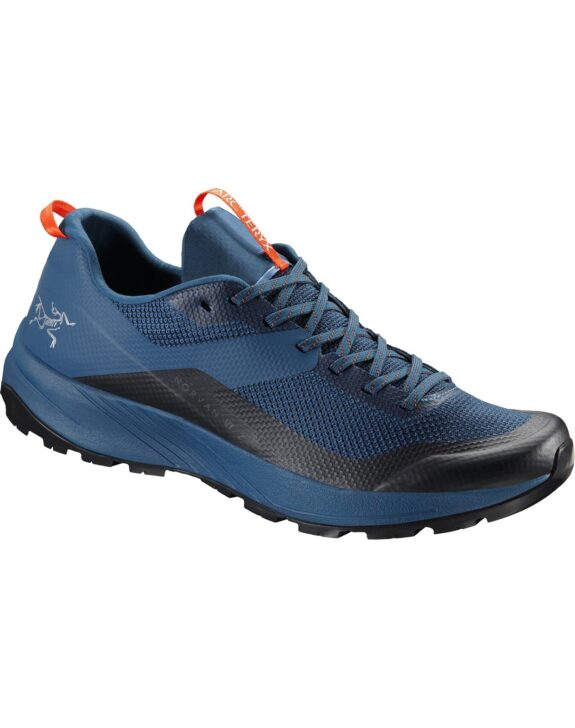
About this Review
This will be a Limited Review of the Arc’teryx Norvan VT 2. I put 211 miles (340 km) on these shoes between April and July of 2020 before their condition deteriorated to a point where they were no longer suitable for backpacking, trail running, or hiking. Approximately half of those miles were put on the shoes during backpacking trips, with the other half being split more or less equally between trail running and hiking.
The backpacking trips were overnight trips with a pack weight between 17 and 31 lbs (8 to 14 kg), depending on how luxurious my hiking partner and I were eating. The high weight was achieved when salad, macaroni and cheese, filet mignon, and wine were on the dinner menu.
Trail runs during the testing period were between 3 and 8 miles (5 and 13 km), and I did not carry a pack during those runs. Hikes during the testing period ranged from 2 to 11 miles (3 to 18 km), and I often carried a daypack under 10 lbs (4.5 kg) on these hikes.
My testing occurred in western Montana and nearby parts of Idaho at altitudes between 2,500 feet and 8,500 feet (762 to 2590 m).
Trail and off-trail conditions ranged between faint footpaths in dusty sagebrush country with loose soil, cruiser trail with solid tread, rocky and rooty trails, sections of packed spring snow, mud, talus slopes, granite slab, thick forest, and wide running paths in a city park.
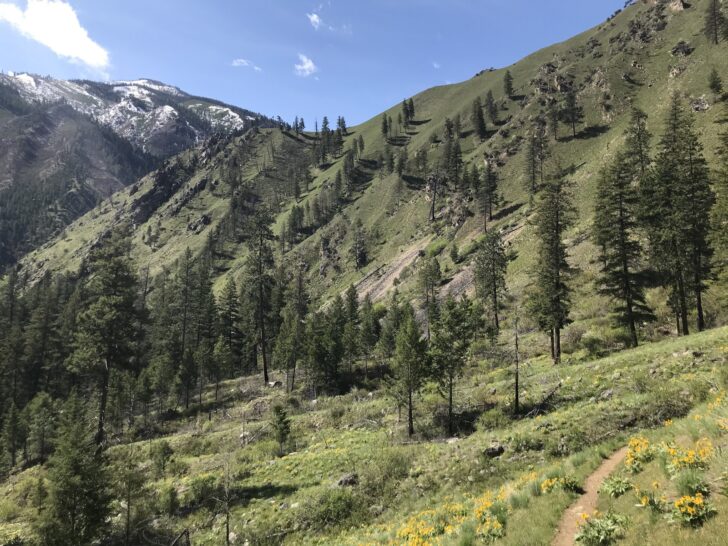
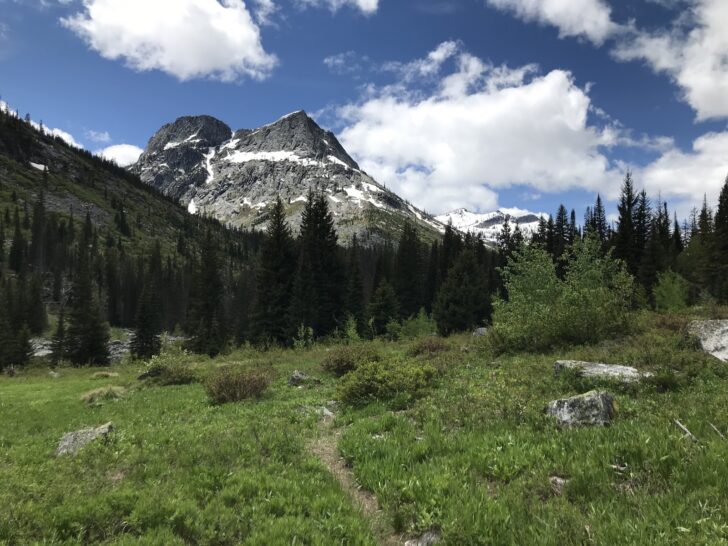
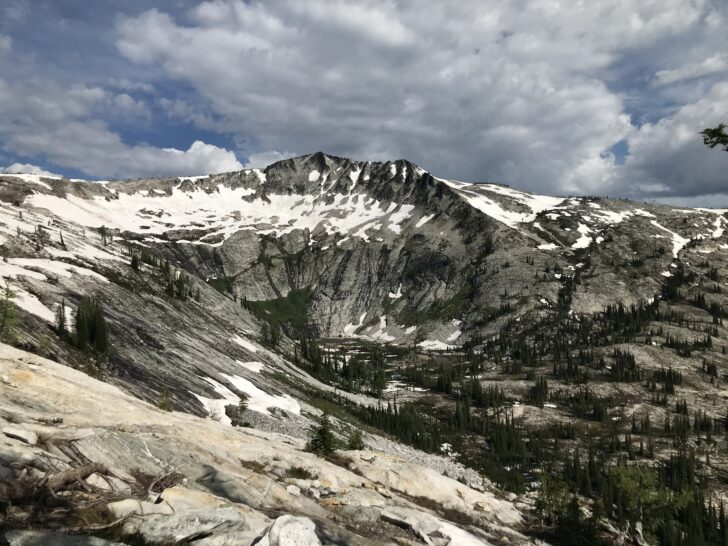
Features and Specifications
- Weight (per shoe, men’s size 9): 11.3 oz (320 g)
- MSRP: $170
- Fit: The fit is on the snug side but not so much as to warrant sizing up as adjusting the lacing allows for a reasonable fit to be dialed in. That said, this is not an ideal shoe for persons with wide feet or whose feet swell more than average when hiking.
- Narrow toe-box
- Mesh upper
- Welded lower
- Toe cap
- TPU rock plate
- 8 mm heel drop
- 8 mm stack height
- 4 mm Vibram Megagrip lugs
- 4 mm sole insert
- Forward eyelet placing
- Tongue pocket for stashing laces

Performance Analysis
As a Limited Review, and therefore not typically covering long-term use, this article focuses on my experience with the Arc’teryx Norvan VT 2 shoes during a shorter testing period. However, since these shoes experienced a review-ending failure after about 200 miles (322 km), it seems unlikely that they would’ve made it through a full Performance Review.

| Criteria | Observations and Issues |
|---|---|
| Fit | As someone who owns numerous Arc’teryx products which fit me perfectly, and who has quintessentially normal feet, I was a bit surprised at the effort required to get the Arc’teryx Norvan VT 2 shoes to fit comfortably. The stiff sole and fairly rigid body provide great stability and protection but make it a bit laborious to dial in a comfortable fit. After a bit of trial and error, and after ending up with a few small blisters after a short trail run, I was able to figure out a system that worked for me. And once it did, I was incredibly happy with the fit of these shoes while hiking. The toe box, as is the shoe in general, is on the narrower side. This results in a snug and secure fit. Despite being snug, I never found these shoes to get uncomfortable on long downhill stretches or during long days of hiking. The only area where I found the fit to deviate from snug and narrow was in the heel. The heel was more roomy than I’m used to, and it took some additional fiddling with the lacing process to adequately secure the shoe in this area and not cause blisters. It’s worth noting that I was unable to easily slip these shoes on and off the way I can with most other trail runners. I had to untie and retie these shoes every time I took them off. This isn’t a big deal when day hiking or trail running, but for backpacking I found it to be mildly inconvenient - especially when getting up in the middle of the night to go to the bathroom or after taking breaks with the shoes off. So if you’re someone that enjoys being able to easily slip in and out of your shoes when backpacking, this might be a considerable downside. |
| Traction & Stability | The stability and traction of this shoe approaches perfection. Once I figured out the lacing tightness and eyelet pattern that worked best for me, these shoes felt like they had been built around my feet. I can’t recall more than a handful of times where I stumbled or had a misstep while testing these shoes. While I’m not a clumsy hiker or runner by any means, I usually have some all-thumbs moment when walking for a long time where I’m less than precise in my steps. This seemed to occur much less frequently with these shoes. On a variety of terrain, from low-angle granite slabs, to undulating trails wrinkled by roots, to steep, loose soil; I felt totally confident in the stability of these shoes to not roll or shift as I ran or hiked. The traction provided by the Arc’teryx Norvan VT 2 shoes is excellent. The deep lugs made muddy or slushy snowy sections less cartoonish as I was able to firmly plant my feet, and with the aid of trekking poles, easily cross them without looking like I’d stepped on a banana peel. As advertised, the deep lugs and aggressive pattern were extremely effective at providing traction in challenging conditions. The traction of these shoes also stood out when traversing on rock. Many cross-country routes in the area where I tested these shoes (western Montana) feature sections of talus, boulder fields, or granite slab. The Norvan VT 2 was the best shoe I’ve ever used in each of these conditions. I’ve never felt as comfortable walking up granite, other than when wearing technical rock climbing shoes, than I have when wearing these shoes. They stick to the rock in a way comparable to approach shoes for rock climbing, but are vastly more comfortable in a less demanding terrain. |
| Durability | It sounds harsh, but the durability is almost non-existent in these shoes. After only 100 miles of hiking, trail running, and backpacking I noticed the first hints of wear on the mesh where it met the welded lower portion of the shoe near the toe box. I figured maybe I’d just snagged it on some particularly sharp talus or branches when I was travelling off trail but that it shouldn’t deteriorate too quickly. I was wrong. The shoes barely lasted another 100 miles before the mesh on the outside of the shoe on the instep of both shoes completely separated. This exposed the thin inner liner of the shoe and impacted the fit, as the shoe was no longer holding its shape in a crucial area. The mesh on the outstep of the shoes was also significantly worn by this time. Frustratingly, the entirety of the rest of the shoes remained functional. The soles in particular looked as if they had barely been worn. The welded lower was holding up admirably and the toe caps showed only slight wear. Minimal to negligible wear was present in other places. Overall, the shoes had a lot of life left in them but due to the failure of the mesh they were virtually unwearable for any active pursuits. Curious about whether or not I had just put these shoes through uniquely tortuous conditions that resulted in their premature demise, I looked online for reviews to see if others had similar experiences. As it turned out, several others had nearly identical failures after similar lengths of use. One reviewer on the Arc’teryx website noted that “the mesh dissolves when it even looks at rocks,” while another commented that, “After three trail runs the mesh had already pulled apart from rubber toe box over the 1st metatarsal. Maybe it's my feet, but both shoes are the same. It's a shame cause the rest of the shoe is in perfect shape.” At least three other reviewers expressed similar concerns about the durability. |
| Breathability & Drying Time | The mesh upper provided adequate but not excellent breathability. The microfiber heel collar, while comfortable, likely limits the breathability for the rear-third of the shoe. Drying time was average once the shoe was drained of any water, but the welded lower portion prevented the quick draining that occurs after a brief step in water. While this wasn’t a major issue, it did lead to delayed drying time while hiking. Once the shoes were off and wiped out with a bandana they dried reasonably quickly. |
| Long-term Comfort | These shoes were very comfortable on trail runs, day hikes, and shorter mileage days when backpacking with a lightweight pack. On shorter backpacking trips, I was in no hurry to loosen up the laces on the shoes or switch to camp shoes once I had reached my destination. After about 12 miles (19 km) of hiking with a backpack, the comfort began to fade and I was glad to be out of the shoes at the end of the day. This can likely be contributed to their rigidity, which provides great stability and excellent protection on rocky terrain, but results in diminishing comfort over time. Overall, the comfort was reasonable when compared to any trail runner but was especially impressive when considering the stability and traction. |
Commentary
What went wrong with the Arc’teryx Norvan VT 2 shoes?
Based on my experience and other reviews, it’s pretty clear that there is a major failure of design, materials, or both, that results in the mesh separating or prematurely wearing out where it meets the welded lower near the metatarsal area.
After reading several reviews and reflecting upon some of the conditions I put the Arc’teryx Norvan VT 2 shoes in, I’m surprised mine lasted as long as they did. Some people noted considerable issues in less than 100 miles. None of the reviews seem to be from persons who used the shoes above and beyond their intended purpose.
When Arc’teryx markets this as “trail running footwear providing grip, performance and durability on varied terrain,” one could reasonably expect it to last more than 100 miles. The failure I experienced when testing these wasn’t as if I took a Honda Civic up a rutted 4WD forest road and was complaining about its performance. It was more akin to taking a Honda Civic on a flat gravel road with a few small potholes and having the axle break.

Based on my previous experience with Arc’teryx products, I was astounded to see a product fail so spectacularly after such moderate use.
To Arc’teryx’s credit, they did provide me with a replacement (in the form of a credit for the purchase price of the shoe to be used on their website) for the defective shoe when I initiated a warranty claim. However, based on my experience and that of others, I have no confidence in using this shoe again for trail running or backpacking in the landscape where I most often travel.
While the VT 2s do have their redeeming points, which I’ll discuss below, the current issues with durability make it impossible to recommend this shoe to anyone. I hope Arc’teryx can keep the parts of this shoe that work and redesign a mesh upper that is more compatible with the demands of trail running and backpacking. Unfortunately, that means they’ll pretty much have to scrap the current stock of these shoes or be prepared to warranty nearly every pair.
Hopefully, we won’t be reading about a mass burial of the shoes being uncovered in a decade or two, similar to the purported mass burial of the ET video game for Atari that failed catastrophically upon its release.
What went right with the Arc’teryx Norvan VT 2 shoes?
Despite my disappointment in the overall performance of the Arc’teryx Norvan VT 2 shoes, they did get several important things right. Comfort and grip being foremost among them. For the type of hiking I do most often in the summer – decently maintained trails combined with cross-country jaunts to peaks, lakes, and passes – these shoes would have been perfect if not for the lack of durability.
I rarely hike more than 12 to 15 miles per day (19 to 24 km), which was the upper limit of the comfort range for this shoe when backpacking. For hikers who regularly do longer days, this shoe would likely not be as comfortable, but most people doing longer days typically stick to trails and so wouldn’t benefit as much from the excellent traction provided by the VT 2s.
Traction
Speaking of traction, the grip on rock was unparalleled by other trail runners I’ve used and was a major strength of these shoes during the testing period. When these wore out, and I switched back to Altra Lone Peak 4s, I immediately and desperately missed the grip of the Arc’teryx Norvan VT 2s when scrambling around on boulders to access the best lakeside spots to cast my fly rod.
The Little Things
Arc’teryx got many little details right with these shoes. The pull straps on the heels are large enough to easily pull them on and to thread them through pack straps and secure them when taking them off to cross a stream (assuming you don’t just wade through with them, which is somewhat less than ideal given that the welded lower retains a bit of water).
For quick stomps across small creeks, they’re fine, but for longer fords, I preferred to take them off and wear my camp shoes. The tongue pocket for storing the laces is brilliant and totally functional. Even on long runs or in thick brush, the laces stayed tucked away.
Toe Cap and Rock Plate
The toe cap actually lived up to the marketing hype. It looks barely used despite having taken heavy abuse when climbing up Class 4 scramble routes and hiking across talus slopes. It dulled many toe stubbings and could last for many more miles before wearing thin. The rock plate was also high-functioning.
I never had to worry about stepping on talus with these shoes. They felt like impenetrable forcefields around my feet in terrain that otherwise would have required me to delicately choose each step to prevent myself from ending up with stone bruises.
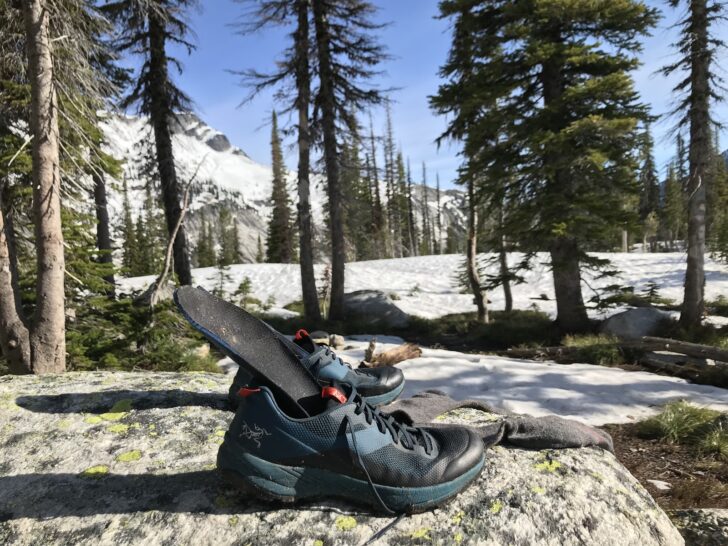
Compared To…
The Arc’teryx Norvan VT 2 is a difficult shoe to compare with other trail runners. Perennial favorites like the Altra Lone Peak series or Brooks Cascadia series lack the rugged sole and attempts at durability that put the VT 2s in a class of their own and are of a substantially different design.
The VT 2’s construction and layout make its closest competitors other shoes in the Arc’teryx Norvan Series. However, neither the Arc’teryx Norvan LD or the Arc’teryx Norvan SL have comparable grip or reinforcement around the lower area, which, in theory, makes the VT 2 more appropriate for rugged treks.
The Arc’teryx Norvan VT 2 shoe vs. The Arc’teryx Norvan SL shoe
| Criteria | Comments | Edge |
|---|---|---|
| MSRP | The Arc’teryx Norvan SL is twenty dollars cheaper than the Arc’teryx Norvan VT 2. | Arc’teryx Norvan SL |
| Weight | The Arc’teryx Norvan SL is significantly lighter (4.8 oz / 136 g) per shoe than the Arc’teryx Norvan VT 2. | Arc’teryx Norvan SL |
| Durability | This is an area where the Arc’teryx Norvan VT 2 should win handily because of its welded lower and durable toe-cap. But the mesh uppers failed after 100 miles, prompting me to award it a tie with the lighter Arc’teryx Norvan SL. | Tie |
| Breathability/Drainage | Full mesh construction gives the Arc’teryx Norvan SL the edge here. | Arc’teryx Norvan SL |
| Grip/Traction | Aggressive 4mm lugs provide superb traction on the Arc’teryx Norvan VT 2. It’s the shoe’s best feature. | Arc’teryx Norvan VT 2 |
| Comfort | The Arc’teryx Norvan VT 2 provides protection on scrambles and talus, but is somewhat stiff compared to traditional trail runners, and requires some thought and experimentation to dial in the fit. | Tie |
Strengths and Limitations
Strengths
- Exceptional traction and grip on technical terrain
- Small details superbly realized
- Toe cap and rock plate are sturdy and hard-wearing
Limitations
- Mesh uppers wore out after 100 miles
- Likely too stiff to be comfortable for long days on trail
- Wide feet beware
Related Content
More by Mark Wetherington
- Mark is one of BPL’s new columnists! Check out the first installment in his column “Unpacked.”
Reviews:
- Andrew Marshall recently reviewed the Xero Shoes Mesa Trail
Forums:
- New to trail runners? No worries. Our community has you covered.
Where to Buy
DISCLOSURE (Updated April 9, 2024)
- Product mentions in this article are made by the author with no compensation in return. In addition, Backpacking Light does not accept compensation or donated/discounted products in exchange for product mentions or placements in editorial coverage.
- Some (but not all) of the links in this review may be affiliate links. If you click on one of these links and visit one of our affiliate partners (usually a retailer site), and subsequently place an order with that retailer, we receive a commission on your entire order, which varies between 3% and 15% of the purchase price. Affiliate commissions represent less than 15% of Backpacking Light's gross revenue. More than 70% of our revenue comes from Membership Fees. So if you'd really like to support our work, don't buy gear you don't need - support our consumer advocacy work and become a Member instead.
- Learn more about affiliate commissions, influencer marketing, and our consumer advocacy work by reading our article Stop wasting money on gear.




Home › Forums › Arc’teryx Norvan VT 2 Shoes Review